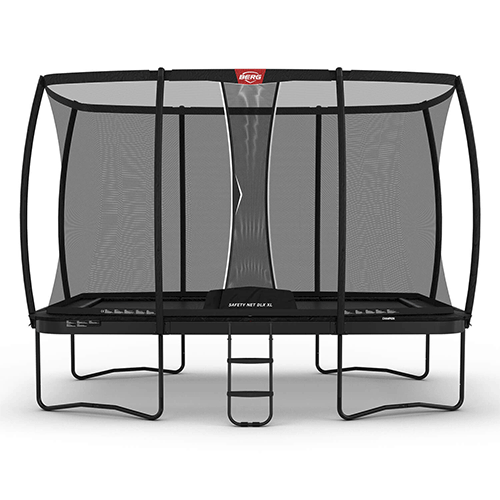
Above Ground Trampolines
Above-ground trampolines are freestanding structures that sit on top of the ground. They are usually surrounded by a safety net, and sometimes come with other safety features such as padding around the edges of the trampoline.
Pros
- Easy to Install: Above-ground trampolines are very easy to install. They can usually be assembled in a few hours with the help of a few people. There is no need to dig a hole or level the ground, making them a great option for those who don’t want to undergo extensive installation work.
- Mobility: Above-ground trampolines can be moved around the yard easily. If you need to mow the lawn or change the placement of the trampoline, it can be done without too much trouble. They are also easy to disassemble and move to a new location if you decide to move house.
- Cost-Effective: Above-ground trampolines are generally less expensive than inground trampolines. They are a great option for families who want to provide their children with a fun activity without breaking the bank.
Cons
- Aesthetics: Above-ground trampolines are often seen as an eyesore in the backyard. They can take up a lot of space and may not be aesthetically pleasing, especially if they are not put away when not in use.
- Safety: Although safety nets and padding are available for above-ground trampolines, they may not be as safe as inground trampolines. The higher frame of the trampoline can make it easier for children to fall off or get injured.
- Durability: Above-ground trampolines are not as durable as inground trampolines. They are exposed to the elements and can deteriorate more quickly. The frame can also bend or warp over time, especially if they are not properly cared for.
Inground Trampolines
Inground trampolines are installed in the ground, so the jumping surface is level with the ground. They are often surrounded by a safety net and have padding around the edges to prevent injury.
Pros
- Aesthetics: Inground trampolines are often more aesthetically pleasing than above-ground trampolines. They are flush with the ground and can blend in with the surrounding landscape.
- Safety: Inground trampolines are generally considered to be safer than above-ground trampolines. Because they are flush with the ground, there is less risk of falling off the trampoline or getting injured.
- Durability: Inground trampolines are more durable than above-ground trampolines. They are not exposed to the elements and can last longer. They are also less likely to warp or bend over time.
Cons
- Installation: Inground trampolines require extensive installation work. A hole needs to be dug and the ground needs to be leveled. This can be time-consuming and expensive, especially if you need to hire a professional to do the work.
- Cost: Inground trampolines are generally more expensive than above-ground trampolines. They require more work to install, and the materials used are often more expensive.
- Immobile: Inground trampolines are not mobile and cannot be easily moved around the yard. Once they are installed, they are there to stay. This can be a problem if you need to move the trampoline to mow the lawn or if you decide to move house.
- Maintenance: Inground trampolines require more maintenance than above-ground trampolines. Because they are installed in the ground, water can collect in the hole and cause the trampoline to deteriorate more quickly. The padding and safety net also need to be regularly checked and replaced as they can become damaged over time.
Which one should you choose?
The decision between an above-ground and inground trampoline ultimately comes down to personal preference and budget. Above-ground trampolines are generally less expensive and easier to install, making them a great option for families who want a fun activity for their children without spending a lot of money. They are also mobile and can be moved around the yard easily.
Inground trampolines are more expensive and require more work to install, but they are generally considered to be safer and more aesthetically pleasing. They are also more durable and can last longer than above-ground trampolines. However, they are immobile and require more maintenance.
If you have a large budget and want a trampoline that is both safe and aesthetically pleasing, an inground trampoline may be the best option for you. However, if you are on a budget and want a trampoline that is easy to install and move around the yard, an above-ground trampoline may be a better option.
Conclusion
Trampolines are a fun and healthy activity for both children and adults. When deciding between an above-ground or inground trampoline, it’s important to consider factors such as safety, durability, cost, and installation. Above-ground trampolines are generally less expensive and easier to install, but they may not be as safe or durable as inground trampolines. Inground trampolines are more expensive and require more work to install, but they are generally considered to be safer and more durable. Ultimately, the decision between an above-ground or inground trampoline comes down to personal preference and budget.

